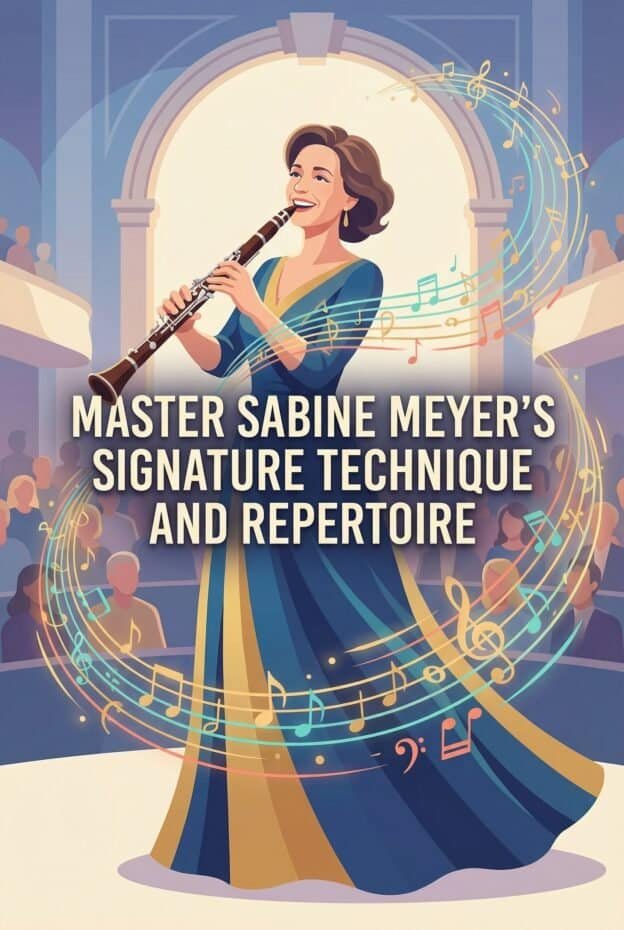Sabine Meyer (born 1960 in Weingarten, Germany) is a leading German classical clarinetist and educator. She became the first woman to serve as principal clarinetist with the Berlin Philharmonic in 1982, began a solo career in 1983, and has been awarded the Niedersachsen Prize (1993) and the Frankfurt Music Prize (2010). Her signature repertoire includes Mozart's Clarinet Concerto in A Major, K.622; Weber's Clarinet Concerto No.1 in F minor, Op.73; and Nielsen's Clarinet Concerto, Op.57. She teaches at the Hochschule für Musik und Theater in Hamburg and is noted for a singer-like tone, breath-shaped phrasing, and chamber-music sensitivity.
Who is Sabine Meyer?
Sabine Meyer is one of the most influential classical clarinetists of the late 20th and early 21st centuries. Born in 1960 in Weingarten, Germany, she reshaped expectations for solo clarinet playing, orchestral roles, and chamber music collaboration. Her work with labels such as EMI Classics and Deutsche Grammophon has reached listeners worldwide.
Known for a warm, vocal tone and refined musical taste, Meyer helped bring the clarinet into the spotlight as a true solo instrument. Her performances of Wolfgang Amadeus Mozart, Carl Maria von Weber, Carl Nielsen, and Johannes Brahms are standard listening for advanced students and professionals. Many conservatories use her recordings as reference interpretations.
Beyond performance, Sabine Meyer is a respected teacher and mentor. At the Hochschule für Musik und Theater in Hamburg she trains the next generation of clarinetists, combining German clarinet traditions with a modern, flexible approach. Her masterclasses in Europe, Asia, and North America influence clarinet pedagogy far beyond her own studio.
Biography & Key Milestones (1960 birth; 1982 Berlin Philharmonic; awards 1993, 2010)
Sabine Meyer was born in 1960 in Weingarten, in the German state of Baden-Württemberg. She grew up in a musical family and began clarinet studies at a young age. Early training with her father and local teachers laid a strong technical foundation, which she later refined at the Hochschule für Musik in Stuttgart and the Hochschule für Musik in Hanover.
Her conservatory years brought contact with leading German clarinet pedagogues and orchestral traditions. Meyer developed a disciplined practice routine, a focus on chamber music, and a serious interest in classical and Romantic repertoire. These years also introduced her to historically informed performance practices that later influenced her approach to Mozart and early Romantic works.
In 1982, Sabine Meyer reached a historic milestone when Herbert von Karajan invited her to join the Berlin Philharmonic as principal clarinetist. She became one of the first women to hold a principal wind position in that ensemble. The appointment sparked debate inside the orchestra but highlighted her exceptional artistry and technical command.
After a brief but intense period with the Berlin Philharmonic, Meyer chose to focus on a solo and chamber music career starting in 1983. This decision allowed her to explore a broader repertoire, commission new works, and collaborate with ensembles such as the Sabine Meyer Wind Ensemble and the Trio di Clarone, often performing with her brother Wolfgang Meyer.
Recognition followed quickly. In 1993, she received the Niedersachsen Prize for Culture, honoring her artistic contributions in Germany. In 2010, the Frankfurt Music Prize acknowledged her international influence as both performer and educator. These awards place her alongside other major classical artists such as Gidon Kremer and Heinz Holliger.
Today, Sabine Meyer balances performance, recording projects, and teaching at the Hochschule für Musik und Theater in Hamburg. She continues to appear with orchestras such as the London Philharmonic Orchestra, the Bavarian Radio Symphony Orchestra, and the Vienna Symphony, while maintaining an active schedule of chamber music and masterclasses.
Signature Repertoire: Mozart K.622, Weber Op.73, Nielsen Op.57 and Brahms Sonatas
Sabine Meyer's signature repertoire centers on four pillars: Mozart's Clarinet Concerto in A Major, K.622; Weber's Clarinet Concerto No.1 in F minor, Op.73; Nielsen's Clarinet Concerto, Op.57; and the Brahms Clarinet Sonatas, Op.120. Her recordings of these works are widely cited in conservatories and professional studios.
In Mozart K.622, Meyer emphasizes elegance, clarity, and a vocal singing line. Her use of basset clarinet in A for many performances reflects historical research into Anton Stadler's instrument. She shapes phrases as if they were arias, with subtle dynamic shading and flexible tempo that still respects Classical style and structure.
Weber's Clarinet Concerto No.1 in F minor, Op.73, highlights Meyer's virtuosity and control of the clarinet's full range. She navigates the leaps and rapid passagework with a smooth legato and even tone from chalumeau to altissimo. Her cadenza choices often stress drama and contrast, while keeping the Romantic character lyrical rather than aggressive.
Carl Nielsen's Clarinet Concerto, Op.57, shows another side of Meyer's artistry. This 20th century work demands extreme dynamic contrasts, sudden mood shifts, and a wide palette of tone colors. Meyer uses a more flexible, sometimes raw sound to capture Nielsen's restless character, while keeping intonation and rhythm precise in the most complex passages.
The Brahms Clarinet Sonatas in F minor and E flat major, Op.120, are central to Meyer's chamber music discography. Her collaborations with pianists such as Oleg Maisenberg and Rudolf Buchbinder show a deep understanding of late Brahms style. She balances warmth and clarity, keeping the clarinet line integrated with the piano rather than dominating it.
For advanced clarinetists, studying these recordings offers concrete models of tempo choice, articulation, and phrasing. For example, comparing her early and later recordings of Mozart K.622 reveals how her concept of Classical style matured, with slightly broader tempi and more nuanced inner phrasing in the later versions.
Sabine Meyer's Interpretive Approach: Phrasing, Breath-Shaping, and Singer-Like Tone
Sabine Meyer's playing is often described as singer-like. This comes from her focus on long, vocal phrases shaped by breath, not by bar lines. She treats each musical line as a sentence with grammar, direction, and emphasis, similar to how a soprano might shape a Mozart aria or a Brahms song.
Breath control sits at the center of her approach. Meyer uses deep, low breathing with strong diaphragmatic support to sustain long phrases at soft dynamics. She avoids shallow chest breathing, which can cause tension and unstable pitch. Her air stream remains steady, even when the dynamic changes, so the tone stays centered.
On the instrument side, Meyer favors a flexible embouchure that allows resonance. Rather than clamping the jaw, she uses firm but relaxed corners and a cushioned lower lip. This setup lets the reed vibrate freely, producing a warm, round sound that can still project in large halls such as the Berlin Philharmonie or the Musikverein in Vienna.
Her articulation reflects this vocal model. In Mozart and Brahms, she often uses a soft, legato tongue, touching lightly at the tip of the reed to start the note without harshness. In Weber and Nielsen, she adds more bite when needed, but the syllable still feels like “du” or “lu” rather than a hard “tu” for most lyrical passages.
Intonation and tone color are closely linked in her playing. Meyer subtly adjusts voicing inside the mouth by raising or lowering the tongue, similar to singing different vowels. For brighter color or higher pitch, she uses an “ee” feeling. For darker color or slightly lower pitch, she moves toward an “aw” or “oh” shape, always coordinated with air support.
In chamber settings, Meyer scales her tone to match partners such as string quartets or piano. She avoids a soloistic edge unless the score clearly calls for it. This flexibility in tone color and dynamic range helps her blend seamlessly with ensembles like the Vienna String Sextet or the Alban Berg Quartet.
Practice Structure & Exercises Inspired by Meyer (warm-up, technical drills, repertoire focus)
While Sabine Meyer has not published a single official method book, her interviews and masterclasses suggest a clear practice structure. Advanced students can adapt this framework to build consistency and musical depth. A typical session includes breathing work, tone and legato exercises, technical drills, and focused repertoire practice.
Start with 5 to 10 minutes of breathing and long tones. Use low, relaxed inhalations and exhale on a comfortable note in the middle register, such as written G or A. Aim for 15 to 20 second sustained notes at mezzo piano, keeping the sound even and the pitch stable. This mirrors Meyer's focus on air as the foundation.
Next, move to slow scales and intervals, always listening for a continuous, vocal line. Practice major and minor scales in slurred octaves, then add thirds and sixths. Use a tuner or drone to stabilize intonation, especially when crossing the break. Meyer often stresses that technical work must always serve musical phrasing, not just finger speed.
For finger technique, incorporate articulated scale patterns and arpeggios at moderate tempos. Focus on evenness of tone and clarity of articulation rather than maximum speed. Practice in rhythmic groupings, such as dotted rhythms, to build control. This approach reflects Meyer's clean, unforced technique in Weber Op.73 and similar repertoire.
Repertoire practice should occupy at least half of the session for advanced players. Choose small sections of Mozart K.622, Weber Op.73, Nielsen Op.57, or Brahms Op.120 and work on phrasing, dynamics, and character. Record yourself and compare your phrasing choices to Meyer's recordings, not to copy but to understand her logic.
End with a short cool down of soft long tones and lyrical excerpts. This helps reset embouchure and air support after intense technical work. Many of Meyer's students report that she encourages daily consistency over marathon sessions, favoring 2 to 3 focused hours spread across the day instead of one long, exhausting block.
Masterclass & Teaching Philosophy (institutions, pedagogical notes)
Sabine Meyer's teaching at the Hochschule für Musik und Theater in Hamburg reflects a blend of German clarinet tradition and her own interpretive insights. She emphasizes musical imagination, stylistic awareness, and a strong technical foundation. Her students often win positions in European orchestras and prizes at competitions such as the ARD International Music Competition.
In masterclasses, Meyer frequently asks students to sing or speak phrases before playing them. This helps clarify direction, articulation, and breathing points. She encourages players to think in longer lines, connecting multiple bars into a single musical gesture rather than stopping mentally at each bar line.
Technical comments often focus on air support and embouchure freedom. Meyer corrects tight jaw positions, collapsed embouchure corners, and inconsistent air speed. She prefers small, precise adjustments rather than drastic changes, respecting each student's physical setup while guiding them toward a more resonant sound.
Stylistically, Meyer insists on clear differences between Classical, Romantic, and 20th century repertoire. For Mozart and early Beethoven, she favors light articulation, transparent tone, and modest vibrato use, if any. For Brahms and late Romantic works, she allows a broader sound, more rubato, and richer dynamics, always within good taste.
Chamber music plays a central role in her pedagogy. Meyer often coaches ensembles at festivals and in Hamburg, focusing on balance, intonation, and shared phrasing. She asks clarinetists to listen as much as they play, matching color and timing with partners. This approach reflects her own long career in chamber groups.
Many of her lessons also touch on practical career topics. Meyer discusses audition preparation, mental focus under pressure, and building a sustainable performance schedule. She stresses that long-term health, both physical and mental, is important for a lasting career, citing her own decades of touring and recording as context.
Chamber Music Techniques: Blending, Balance, and Ensemble Listening
Sabine Meyer's chamber music discography, including collaborations with the Vienna String Sextet and the Trio di Clarone, offers a model for clarinetists who want to excel in ensemble settings. Her approach centers on flexible tone, careful dynamic control, and intense listening to colleagues such as violinists, violists, cellists, and pianists.
Blending begins with tone color. Meyer adjusts her sound to match the ensemble, using a slightly narrower, more focused tone with string quartets and a broader, warmer sound with piano. She avoids a bright, soloistic edge unless the score clearly places the clarinet in the foreground, such as in exposed passages of the Brahms sonatas.
Balance depends on dynamic awareness. In rehearsal, Meyer often asks for specific dynamic ratios, such as playing at “one level under” the first violin or piano right hand. Clarinetists can practice this by recording rehearsals and checking whether the clarinet line is too present, too distant, or just integrated enough to support the texture.
Ensemble listening is another key skill. Meyer tracks not only pitch and rhythm but also vibrato speed, articulation style, and phrase length in her partners. She then mirrors or complements these details. For example, if the cello uses a gentle, slow vibrato, she may respond with a slightly warmer, less focused clarinet tone to match the color.
Breathing and cueing also shape her chamber work. Meyer often breathes with the group before entries, even when she does not play on the downbeat. This shared preparation helps unify tempo and character. She uses small visual cues, such as eye contact or a slight body motion, to coordinate starts and releases with colleagues.
For clarinetists, practical exercises include playing string quartet movements on clarinet with a recording, matching articulation and phrasing, or rehearsing Brahms Op.120 with piano at very soft dynamics to force careful listening. These habits reflect Meyer's belief that chamber music refines a player's sensitivity and overall musicianship.
Troubleshooting Common Clarinet Issues (intonation, tone, articulation) with Practical Fixes
Sabine Meyer's masterclasses often address recurring clarinet problems: unstable intonation, uneven tone across registers, and unclear articulation. Her solutions combine instrument setup, body use, and musical awareness. Advanced players can adapt these ideas to their own practice, regardless of equipment brand.
For intonation, Meyer stresses voicing and air support before equipment changes. If high notes are sharp, she suggests slightly lowering the tongue position and relaxing the jaw while keeping strong air. If low notes sag flat, she encourages more focused air speed and a firmer embouchure cushion, not biting but supporting the reed consistently.
Tone problems often come from tension. Meyer asks students to check for tight shoulders, stiff wrists, or a locked jaw. She may have them play a passage on just the mouthpiece and barrel, listening for a stable concert F or F sharp, then transfer that resonance to the full instrument. This helps align embouchure and air for a more centered sound.
Articulation clarity depends on tongue placement and air continuity. Meyer prefers a light tongue stroke at the tip of the reed, with air flowing before and after the articulation. If staccato notes sound pecky or choked, she asks students to think “short air” rather than “short tongue,” keeping the air energized even on very short notes.
Instrument anatomy also plays a role. Mouthpiece facing, reed strength, and ligature position all affect response and intonation. Meyer generally favors medium-strength reeds that allow flexibility and color changes. She rotates reeds regularly and adjusts reed placement so that only a thin line of tip shows above the mouthpiece, balancing response and stability.
Regular maintenance supports all of these troubleshooting steps. Daily swabbing, cork grease on tenons, and gentle key checks help prevent leaks and mechanical issues that can mimic embouchure or air problems. Meyer encourages annual visits to a skilled technician to check pads, springs, and key alignment, especially before major tours or auditions.
Recordings, Awards & Archival References – discography notes and recommended listening
Sabine Meyer's discography spans labels such as EMI Classics, Deutsche Grammophon, and Sony Classical. Her recordings of Mozart K.622, Weber Op.73, Nielsen Op.57, and the Brahms Op.120 sonatas are important listening for serious clarinetists. Many of these albums have won prizes from organizations like the Echo Klassik and the Deutsche Schallplattenkritik.
For Mozart's Clarinet Concerto K.622, start with her recording on basset clarinet with the Berlin Philharmonic, which showcases a transparent, elegant sound and historically informed phrasing. Compare this with a later recording with the Staatskapelle Dresden to hear subtle shifts in tempo and articulation that reflect her evolving interpretation.
Her Weber Concerto No.1 in F minor, Op.73, recorded with the Dresden Staatskapelle, demonstrates her technical brilliance and Romantic style. Listen for the smooth legato in the second movement and the controlled virtuosity in the finale. These performances are often used as benchmarks in conservatory audition preparation.
For Nielsen's Clarinet Concerto, Op.57, seek out her recording with the Berlin Radio Symphony Orchestra. The contrast between lyrical passages and aggressive, almost chaotic sections highlights her range of tone colors and dynamic extremes. This recording is especially useful for players preparing the concerto for competitions or orchestral auditions.
In chamber music, her Brahms Clarinet Sonatas Op.120 with pianist Oleg Maisenberg or Rudolf Buchbinder offer rich insights into late Romantic phrasing and balance. Pay attention to how she shapes long lines in the F minor sonata and how she blends with the piano in the E flat major sonata, never overpowering but always present.
Archival interviews and masterclasses, including televised sessions on German broadcasters such as ZDF and ARD, provide additional context. These documents show Meyer discussing her approach to tone, breathing, and style, and they often include short demonstrations of specific passages from Mozart, Weber, and Brahms.
Key Takeaways
- Sabine Meyer's artistry centers on a singer-like tone, breath-shaped phrasing, and stylistic clarity across Classical, Romantic, and 20th century repertoire.
- Her signature works, including Mozart K.622, Weber Op.73, Nielsen Op.57, and Brahms Op.120, offer rich models for tempo, articulation, and musical character.
- Practical lessons from her approach include structured practice, careful attention to air and embouchure, flexible tone for chamber music, and regular instrument maintenance.
FAQ
What is Sabine Meyer?
Sabine Meyer is a German classical clarinetist and educator born in 1960 in Weingarten. She became principal clarinetist of the Berlin Philharmonic in 1982 and later built a major solo and chamber career. She is known for her refined tone, influential recordings, and teaching at the Hochschule für Musik und Theater in Hamburg.
What clarinet concertos and sonatas is Sabine Meyer best known for?
Sabine Meyer is best known for her interpretations of Mozart's Clarinet Concerto in A Major, K.622, Weber's Clarinet Concerto No.1 in F minor, Op.73, and Nielsen's Clarinet Concerto, Op.57. In chamber music, her recordings of Brahms's Clarinet Sonatas, Op.120, are widely admired and often used as reference versions by advanced students and teachers.
How does Sabine Meyer shape phrasing and tone on the clarinet?
Meyer shapes phrasing with a vocal concept, treating lines like sung sentences. She uses deep, supported breathing and a flexible embouchure to sustain long phrases and maintain a warm, resonant tone. Her articulation is generally light and legato, and she adjusts tone color and dynamics to fit the style and ensemble context.
What practice routine does Sabine Meyer recommend for mastering classical repertoire?
While she has not published a formal method, Meyer's teaching suggests a routine of breathing and long tones, slow scales and intervals, articulated technical drills, and focused repertoire work. She emphasizes daily consistency, musical intention in all exercises, and careful listening, often encouraging students to record themselves and compare with reference performances.
How can I improve blending and balance in chamber music like Meyer?
To blend like Sabine Meyer, adjust your tone color to match your ensemble, play slightly under the dynamic of leading voices, and listen closely to articulation, vibrato, and phrase length in your partners. Practice at soft dynamics, record rehearsals, and experiment with different sound shapes so your clarinet can either merge into the texture or emerge clearly when needed.







